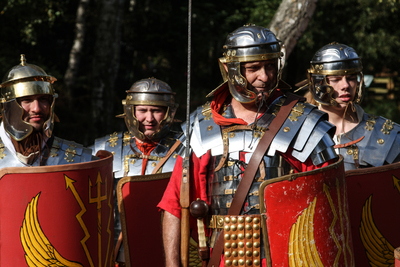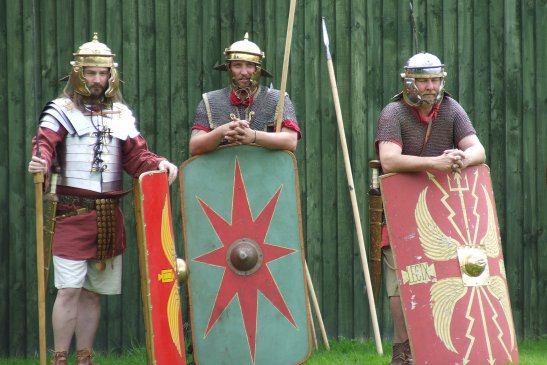The Vicus represents two Roman military units.

A Vexillation of Legio IX Hispana.
The choice of portraying Legion IX was an easy one as most of the legions that were present during the invasion and early occupation of Britain were already being portrayed in the UK and also the ninth does seem to have been involved in many of the significant military events.
The Legion goes back to at least the the time of the divine Julius as it is present in Gaul during it's conquest. It has battle honours for both Hispana and Macedonia, but seems only to commonly use Hispana.
The legion was involved in the invasion of Britain in 43AD, under its commander Aulus Plautius and known to have played a part in the Boudican revolt of 60AD. It is likely that the legion was also present at the battle with Venutius in AD72, at Stanwick, as they were based in the north but they were definitely with Agricola in 83AD, in Scotland.
Legionary soldiers were required to be citizens of the empire, which at this period would have excluded the vast majority of provincial people. It was a well paid job with good conditions of service and very real prospects of promotions. The soldiers received gratuities from new emperors (of which there could be a few during their service) as well as a grant of land/cash in lieu at the end of their 25 years.
The Legionary was solely a heavy infantryman and very heavily equipped for this period (and others) . The legions also had ancillary skills in building and engineering on both military and civilian projects.
The Vicus legionary must not only be able to carry his equipment, he must also be able to fight competitively against our Britons. Not just a life of drill and marching for us!
Primary weapon for the Legionary are the pila, with the gladius being used for close combat. The Gladius, is NOT (and contrary to popular myth) a stabbing weapon. It is an excellent cut and thrust weapon. You only have to use it, to appreciate this.
"However, according to the Roman methods of fighting each man makes his movements individually: not only does he defend his body with his long shield, constantly moving it to meet a threatened blow, but he uses his sword for both cutting and for thrusting. Obviously, these tactics require a more open order and an interval between the men, and in practice each soldier needs to be at least three feet from those in the same rank and from those in front of and behind him if he is to perfom his function efficiently."
[Polybius XVIII]
We are affiliated to the other vexillations of Legio IX around the world; the main one being that in the USA and are proud to carry the same shield design that marks us as such.
Some relevant articles in our Resources section are:

Coh I Brittonium M. Ulpia Torquata P.F.C.R. ((Miliaria Ulpia Torquata Pia Fidelis Civium Romanorum)
There is far less information available on the Auxillia cohorts, they are rarely mentioned by name in Roman sources (apart from a few notable exceptions) and only detected through inscriptions left behind.
We wanted to use a British Cohort as we felt it would give us an opporunity to show the other side of the Roman military machine in the context of local recruiting. We also wanted to utilise the Danum (Doncaster) shield which we believed to be an Auxillia shield from a period context. We know by working back from discharges that cohorts with a British designation were recruited at least as early as the 70AD and it's possible that the Britons present with Agricola in AD83 were local cohorts.
Given the Roman policy on recruitment into the auxillia, then it's likely that units were being raised far earlier than either of these dates imply.
While our British cohort is armed in the Roman style it still retains much of it's native clothing.
Auxillia performed all the other roles that the legionary heavy infantry were not suited for. In addition, the auxillia seemed to have been reserved very much for actual fighting, as opposed to the other activities that the legionary undertook. Whether they weredeemed more "expendable" than the citizens or simply more flexible and suited to that role is debatable.
 This is the design for the front of the cohorts shields, it's one we lifted from Trajan's column (although the colours are guesswork). If you see them about with other groups, then it's Vicus members "moonlighting' !!!
This is the design for the front of the cohorts shields, it's one we lifted from Trajan's column (although the colours are guesswork). If you see them about with other groups, then it's Vicus members "moonlighting' !!!Primary weapon for the auxillia is the hasta (spear), or more likely more than one, with either a gladius or spatha for close up work.
You can read all about our experiences in Germania here:
The evidence that our unit existed comes from a military diploma:
"IMP CAES DIV NERV F NERVA TRAI AVG GER DAC PONT MAX TR P XIIII IMP VI COS V PP PEDITIBVS ET EQVITIBVS QVI MILITANT IN COH I BRITTONVM M VLPIA TORQVATA P F C R QVAE EST IN DACIA SVB D TERENTIO SCAVRIANO QVORVM NN SVBSCRIPTA SVNT PIE ET FIDELITER EXPEDITIONE DACICA FVNCTIS ANTE EMERITA STIPEDIA CIV R DEDIT
A D III IDVS AVG DARNITHETHI L MINICIO NATALE Q SILVANO GRANIANO COS PEDITI
M ULPIO ADCOBROVATI F NOVANTICONI RATIS"
"For the emperor Caesar Nerva Trajanus Augustus Germanicus Dacicus, son of the divine Nerva, High Priest, holding tribunician power for the fourteenth time, hailed Imperator in the field six times, consul five times, Father of his Country.¹ To the foot-soldiers and horse- soldiers serving in the First Ulpian Cohort of Loyal and Faithful Britons, one-thousand strong, citizens of Rome, awarded with torques, who are in Dacia under [the governor] Decimus Terentius Scaurianus, and whose names are here appended, for loyal and faithful service in the Dacian campaign, before the completion of their military service, are hereby granted Roman citizenship.
On the third day before the ides of August.²
At Darnithethis.³
When Lucius Minicius Natalis and Quintus Silvanus Granianus were Consuls.²
To the foot-soldier Marcus Ulpius Novantico, son of Adcobrovatus, of Ratae."
(Burn 71; bronze military diploma from Dacia)
Some relevant articles in our Resources section for auxillia are:
Making a Danum shield
Auxillia Dress
Making a shield (by Neil Lucock)
Making Roman Marching Boots
The Vicus © 2004
All information on this website has been written by members of the group unless other source has been stated. All photographs have been taken by members of the group and belong to The Vicus. Any images not taken by the group have been credited.
HOME ● WHAT WE DO● EVENTS ● MEMBERSHIP ● BOOKING ● GALLERY ● CONTACT ●GLADIATORS ● BRITISH WARRIORS ● ROMAN UNITS● RELIABLE RESOURCES